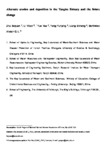Alternate erosion and deposition in the Yangtze Estuary and the future change
| dc.contributor.author | Zhu, B | |
| dc.contributor.author | Li, Y | |
| dc.contributor.author | Yue, Y | |
| dc.contributor.author | Yang, Y | |
| dc.contributor.author | Liang, E | |
| dc.contributor.author | Zhang, C | |
| dc.contributor.author | Borthwick, Alistair | |
| dc.date.accessioned | 2021-08-22T12:31:34Z | |
| dc.date.available | 2021-08-22T12:31:34Z | |
| dc.date.issued | 2020-01 | |
| dc.identifier.issn | 1009-637X | |
| dc.identifier.issn | 1861-9568 | |
| dc.identifier.uri | http://hdl.handle.net/10026.1/17672 | |
| dc.description.abstract |
The morphological changing trend of the Yangtze Estuary, the largest estuary of Asia, has become a focus of research in recent years. Based on a long series of topographic data from 1950 to 2015, this paper studied the erosion-deposition pattern of the entire Yangtze Estuary. An alternation between erosion and deposition was found during the past 65 years, which was in correspondence to the alternation between flood and dry periods identified by multi-year average duration days of high-level water flow (defined as discharge ≥ 60,000 m3/s, namely, D≥60,000) from the Yangtze River Basin. A quantitative relationship was further developed between the erosional/depositional rate of the Yangtze Estuary and the interpreting variables of yearly water discharge, D≥60,000 and yearly river sediment load, with contributing rates of 1%, 59% and 40%, respectively. Mechanism behind the alternate erosion and deposition pattern was analyzed by examining residual water surface slope and the corresponding capacity of sediment transport in flood and dry periods. In flood periods, a larger discharge results in steeper slope of residual water level which permits a greater capacity of sediment transport. Therefore, more bed materials can be washed to the sea, leading to erosion of the estuary. In contrast, flatter slope of residual water level occurs in dry periods, and deposition dominates the estuarine area due to the decreased capacity of sediment transport and the increased backwater effect of flood-tide. Coastal dynamics and estuarine engineering projects alter the local morphological changes, but slightly affect the total erosional/depositional rate of the whole estuarine region. Heavy sedimentation within the Yangtze Estuary after the impoundment of the Three Gorges Dam can be attributed to the reduced occurrence frequency of flood years due to water regulation by the dam, and largely (at least 36%–52%) sourced from the sea. Deposition is still possible to occur in the Yangtze Estuary in the future, because the multi-year average D≥60,000 is unlikely to exceed the critical value of 14 days/yr which corresponds to the future equilibrium state of the Yangtze Estuary, under the water regulation of the large cascade dams in the upper Yangtze. Nevertheless, the mean depositional rate will not surpass the peak value of the past years, since the total sediment load entering the Yangtze Estuary has presented a decreasing trend. | |
| dc.format.extent | 145-163 | |
| dc.language | en | |
| dc.language.iso | en | |
| dc.publisher | Springer Science and Business Media LLC | |
| dc.title | Alternate erosion and deposition in the Yangtze Estuary and the future change | |
| dc.type | journal-article | |
| dc.type | Journal Article | |
| plymouth.issue | 1 | |
| plymouth.volume | 30 | |
| plymouth.publication-status | Published | |
| plymouth.journal | Journal of Geographical Sciences | |
| dc.identifier.doi | 10.1007/s11442-020-1720-0 | |
| plymouth.organisational-group | /Plymouth | |
| plymouth.organisational-group | /Plymouth/Faculty of Science and Engineering | |
| plymouth.organisational-group | /Plymouth/Faculty of Science and Engineering/School of Engineering, Computing and Mathematics | |
| plymouth.organisational-group | /Plymouth/Users by role | |
| plymouth.organisational-group | /Plymouth/Users by role/Academics | |
| dc.identifier.eissn | 1861-9568 | |
| dc.rights.embargoperiod | Not known | |
| rioxxterms.versionofrecord | 10.1007/s11442-020-1720-0 | |
| rioxxterms.licenseref.uri | http://www.rioxx.net/licenses/all-rights-reserved | |
| rioxxterms.type | Journal Article/Review |


